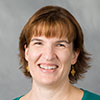This article is more than 5 years old.
This morning’s plenary panel on the future of libraries in HE was presented by Dr. Annette Haggray (Dean at College of DuPage), Lisa Hinchliffe (Head of UG Library at U of IL at Urbana-Champaign) and Christopher Stewart (Dean of Libraries at IL Institute of Technology).
Univ of Illinois:
- RESEARCH is primary
- 11 million vols in Library
- how do we reposition ourselves in an era when having a lot of print stuff is not what makes a great research institution –
- 10,000 graduate students!
- how do the research libraries serve the undergraduate student?
- how do we connect with student habits, traditions, patterns?
- Put the library where the students will ‘stumble’ over it
- Best thing about being a librarian is helping students reach their dreams
College of DuPage
- Community College (largest in IL – top 4 in country)
- multiple missions – education, workforce development, community outreach, economic stimulation,
- Deeply embedded in community –
- many non-traditional students, online, experiential learning,
- Library helps faculty with instructional development and design
- increasing number of students who are underprepared or unprepared and of non-native speaking students – library will have a growing role in both of these
Illinois Institute of Technology
- known for science, technology, engineering and architecture
- Mies Van der Rohe designed the campus – library is a knock off 😉
- Libraries 1.8 million volumes; 30,000 digital journal titles
- Flashpoint of financial tsunami that is affecting libraries — all of their research areas are the expensive titles…..
- Information Literacy is a bit different for science and technology libraries — much more reliant on a primarily online environment for their research — they will be the ones building our buildings, bridges, schools, airplanes — VERY important that they know how to do good research
Question to panelists: Where will we be in the future?
- What will the value of the university be in 10 years? What are the President and Provost reading? Quality, measurement, regulations, value, markets, prestige (not related to quality), efficiency will all impact IHEs — where does the library fit in with all of these things — has the library become part of the problem or part of the solution to addressing these issues?
- Are we going to be an institute of the future or the past? Given the way funding, regulation, student as consumer model are going – do we answer in what we were in the past or what we need to be in the future. What does pursuing quality aggressively mean?
- Do we have the courage to bring in and welcome the new librarians seeking to come in and work with us and take us in future-looking directions or will we drive them away to other more future-looking professions
- Library does not ‘OWN’ information literacy — we bring IL to the table and ask faculty ‘how will you work with us on this?’ — we need to address how to define it collectively and collaboratively within the disciplines.
- Market share of for-profit institutions is growing — neither faculty nor librarians own the curriculum – they have addressed efficiency in the educational enterprise — Univ. of Phoenix now has 300,000 students
- Illinois State study on how they got such great results integrating IL into the curriculum — librarians were on the committees, volunteered for the jobs others didn’t want (like policy writing) and did the work they said they were going to do….had a profound impact on the policies and the speed at which they were created and adopted
- Offer the library up as a solution to problems on campus – space, services, events, etc.
Question to Panelists: How do we market libraries?
- Marketing is about your brand – get students to connect your brand with learning – not just with stuff or with a place
- Marketing potential exists in EVERY transaction within the library
- Make sure the marketing is in line with the institutional brand – let the institution print your marketing materials
- Staff (not librarians) often have more transactions with our patrons than librarians do (student workers even more) — be sure you include them in any discussion of marketing
- Reconceptualize the job of the student workers — customer service model — so many barriers between a student and a librarian – make sure ALL their interactions are positive and service-oriented
- Market Librarians’ office hours —
Question to Panelists: How do we create a welcoming environment?
- Don’t make assumptions about your students and how they expect to be treated in your enviroment
- New or renovated spaces bring in more people
- Library should be the symbolic starting place on campus
- Library is the only place where it is socially acceptable to be alone (never thought of that!)
- Libraries should start to think of multi-use possibilities — writing center/writing lab; eating/drinking;
- Part of the reason we get space based on books is because that is how we have sold the need for more space — we need to discuss the need for space for collaboration, student study, staff connecting with students, etc. Change the sales pitch!
- Career counseling, campus help desk, academic advising, wellness center all have on-site hours in the library — don’t have to bring the office into the building – just the services — set up a consultation desk — have organization schedule time at the consultation desk
- Prioritize your space for your people, not your books. Let books be off-site and let students connect with the librarians
- University of Chicago is doing the opposite –new space coming — all monographic titles would be browsable in the new building — only moved journals off-site. Gathering in all of their monographs to one location.
